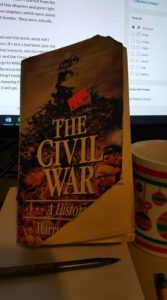
As part of my research for Documenting America: The Civil War Edition, I picked up a used copy of The Civil War, by Harry Hanson. Originally published in 1961, my paperback copy dates from 1991. The book is about 650 pages, with a dozen maps and a fair index.
My overall recommendation: If you must read a book about the Civil War, I think you can do better than this. However, if you like battles and details about military conflict, you might like this.
I picked this up used (like so many of my books) for $1.00, thinking it might be a good reference for my book. About four or five months ago I started reading it, but laid it aside. When I picked it up again in December, I started reading where the bookmark was, in the chapter on the Monitor and the Merrimack. I continued on, through endless battles.
That’s what this book mostly was, the battles—between the Union and the Confederacy, and between the Union generals and their superiors. Much time was given to McClelland’s difficulties with Lincoln, Stanton, and Halleck. Once McClelland was given the book, the battles became between his successors and their commander-in-chief.
The battles are interesting, of course, but the book bogged down on them, focusing on them, almost to the exclusion of politics and other national issues. The materials I’ve gleaned from the Annals Of America have been much more useful for my book. When reading of battles, it becomes impossible to keep the generals straight, except for the few top dogs. So I was reading about some battle, an important battle, and how Brigadier General Smith pushed back Major General Jones’ division, with the help of General White’s cavalry and Colonel Black’s artillery. But which side was which of these on? At the beginning of the battle description the author gave the main units for each side, and who their generals were, but remembering all of them by the time you get a few pages into the description was impossible; at least for me it was.
 The paperback has a few maps, none of which are particularly readable. A map with the units and their commanders on it would have been most helpful. Even just a simple map with cities and the location of armies would have been good. But the book didn’t have that.
The paperback has a few maps, none of which are particularly readable. A map with the units and their commanders on it would have been most helpful. Even just a simple map with cities and the location of armies would have been good. But the book didn’t have that.
When I got to the end of the book, I went back to the beginning to refresh myself on the Introduction/Preface/Forward—whatever was in the book. When I did so I discovered I hadn’t started from the beginning. I must have skipped the first few chapters and gone right into the battles. Silly me. So I read those chapters, which were about everything that happened before Fort Sumter. They were actually pretty good.
So, if I go to Amazon or Goodreads and rate this book, what will I give it? Certainly not better than 3 stars. It’s not a bad book; just not what I was looking for or needed for my research, not did I think it was a good general history of the war and the times. If I need to know something about a battle, I can go to Wikipedia (don’t laugh; for things like battles it’s actually quite accurate and useful, with good maps on the screen) for everything I need, supplemented by my two encyclopedias. So, I won’t be keeping this book, nor rereading it. Into the yard sale stack it will go.